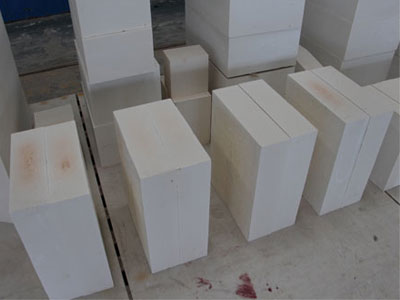The composition of fused zirconia corundum bricks is: baddeleyite, corundum, a small amount of mullite, glass phase and pores. In order to reduce and eliminate residual thermal stress, a certain amount of glass phase is required in the product as an absorbent to buffer thermal stress. However, the glass phase is the weak link in the resistance to glass erosion of fused bricks. In the process of erosion, the glass phase first seeps out and replaces with the high-temperature glass melt, thereby accelerating the erosion of the crystal phase. The glass phase will also seep out under high temperature conditions, accompanied by the release of air bubbles, which will contaminate the glass melt. The segregation phenomenon of fused bricks is also manifested in the glass phase. In the series products with zirconium content of 33#, 36#, and 41# of electric fused bricks, the glass phase content is 20℅-14℅, so the influence of its properties on the quality of electric fused bricks cannot be ignored. AZS three-element alumina, zirconia, and silica theoretically do not have a glass phase. Even if there is a small amount of impurities, there will be very little glass phase when no alkali oxide is added. Most of the silicon oxide enters the glass phase due to the introduction of basic oxides (sodium oxide) during production. Sodium oxide (encapsulating potassium oxide) together with silica and alumina forms the backbone of the glass phase. The content of sodium oxide in the raw material was reduced from 1.37℅ to 0.65℅, and the amount of glass phase was significantly reduced from the original 21.5℅ to 12℅. Increasing the sodium content apparently reduces the viscosity of the glass phase. When the sodium content is less than 1℅, it is an ideal range. Impurities such as iron oxide, titanium, calcium, and magnesium, from the perspective of improving the performance of the glass phase and reducing pollution to the molten glass, the less the amount, the better. The increase of these numbers will increase the number of glass phases and reduce the viscosity of glass phases, which will not only pollute glass products but also affect the service life of products. The content of iron oxide and titanium is controlled at less than 0.2℅. In the production process of AZS electric fused bricks, (1) the content of iron and titanium is less than 0.2℅; (2) the content of sodium and sodium is less than 1℅; (3) the silicon is strictly controlled in detail content. In order to improve the service life of electric fused bricks and improve the quality of glass fusion products, the key is to master the intrinsic composition properties of bricks. AZS fused brick products have the lowest degree of pollution to the glass, and the maximum service life of the bricks is the high-quality product and the guarantee to increase the market share.



